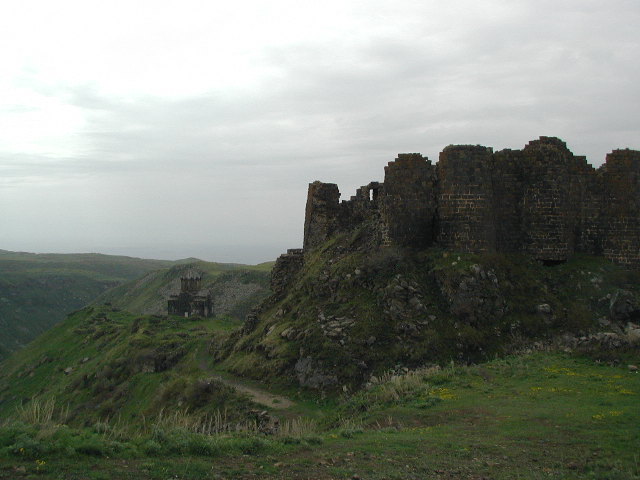
Formalities on the Armenian side took a little while, for no apparent reason. Eventually, they asked me to come in and fill out a customs declaration form. They had this form only in Russian and I was rather surprised that I seemed to understand it better than my guide, Anna, did. They stamped it, checked my bags, asked me about 12 times if I was carrying any guns, and that was it. I wanted to get a copy of the form but couldn't figure out how to persuade them that they should give it to me. According to Anna, the crossing at Bavra is a fairly uncommon one for tourists (most of whom are coming from Tbilisi, not from Bakuriani), and the officials there may not be well informed about the actual rules.
At any rate, Anna gave me a copy of my itinerary, a map of Yerevan, and a brochure about tours of the country. The road to Gyumri was not quite as bad as the road on the Georgian side of the border had been, but it wasn't great either. Arthur (my driver) had claimed that Gyumri was only about a half hour from the border, but it was more like an hour and a half. Lonely Planet had mentioned that there's a statue of Valentina Tereshkova (the first woman in space) in Gyumri, but Anna was unfamiliar with it. She did, however, point out a textile factory that Tereshkova had worked in.
Gyumri was pretty much leveled by an earthquake in 1988, so there aren't many old buildings. There is still a lot of rebuilding going on, most of it financed by people of Armenian descent in other countries. For example, there's a huge arch and a statue of Charles Aznavour because he donated a lot of money to the effort. There were a lot of teenagers dressed up and Anna said it was because of graduation day. We settled into the Red Cross Hotel (also known as the Gastehaus Berlin), which was built by the German Red Cross as part of a complex that included a clinic. This was actually one of the fanciest places that I stayed on the whole trip, by the way. After settling in, we walked over to a nearby restaurant, located in a museum. The streets along the way were basically all rubble, but at least the earthquake provided a good excuse. The restaurant was nicely decorated, with beautiful rugs hanging on the walls. There was also music playing and Anna and Arthur seemed pleased that I liked the Armenian folk music. As for food, we started with salad and cheese. You put cheese and herbs in lavash (thin bread) and roll it up. There was also a very tasty potato salad and barbecued chicken wings, followed by baklava and coffee. Armenians drink what we'd call Turkish coffee, but they'd never refer to it that way.
In the morning, after breakfast, we set out to the southeast. The dominant feature of the Armenian landscape is rocks. Think of planting a rock wherever there should be a tree on a hillside and that's what Armenia looks like. There's an Armenian legend about this, which Anna told me. When G-d created the world, He distributed the good land among all the countries, sifting out rocks onto the ground at His feet. Then He gave out the land to all the nations. Three nations came late - the Georgians, the Armenians, and the gypsies. The Georgians came first and He asked why they were late. They explained that they had followed His instructions and made wine. Then they had to taste the wine and that meant making a toast. They took so long with the toast, that they were late. G-d thought this was a good excuse and, as He had a parcel of land that he's been saving for Himself, He gave it to them. Which is why Georgians live in Paradise. Then came the Armenians. When G-d asked why they were late, they explained that He had given them a lot of work to do and they wanted to finish it before coming to Him. He thought this was a good excuse, but the only land He had left was the rocky patch at His feet, so the Armenians had to settle for this. And when the gypsies came, there was no land left at all, so they were forced to wander for all time.
At any rate, we drove along to the town of Aghtsk, where we turned off the main road and up a long switchback to go to the Ambered Fortress. This was a fairly scary road, as there are a lot of sharp turns and rock falls along the way. This is the only fortress in Armenia which is accessible by road. Its construction began in the 7th century and continued through the 11th. It's surrounded by cliffs on three sides, which protected it for a long time. But Tamerlane still managed to sack it in the 14th century.

We drove back down to the main road and on to Yerevan, which was a much shorter drive than Arthur and Anna had led me to believe. Along the way, Anna told me several legends, including two about Tamerlane. In one, he saw a monk walking on water and had the monk brought to him. He asked to learn how to do this also. The monk said he needed to be free of sin. When Tamerlane asked how he could do that, the monk told him to liberate the Armenian people.
In the other story, a priest helped Tamerlane and, in exchange, asked to be allowed to save as many people as would fit in his church. The church was small, holding maybe thirty people, so Tamerlane agreed. But people kept going in - hundreds of them. When Tamerline investigated, he found that the people inside turned into doves, which flew out the window to freedom. Anna said that there are really secret tunnels used to escape, but that doesn't make so good a story.
Our first stop in Yerevan was at the Genocide Memorial. I passed on the museum on the grounds that it would be too gruesome. The main memorial is an obelisk, which is covered in scaffolding. And, due to reconstruction, the eternal flame at the memorial was not burning. There was, however, music playing, and a lot of people brought flowers. The grounds are heavily wooded, as one tree was planted for each person killed in the 1915 genocide. One section of trees was planted by various dignitaries. For example, I noted a plaque showing one planted by Senator Robert Dole.
We had lunch nearby, at a very attractive restaurant in the woods. The restaurant also had caged animals - a hawk and a very unhappy looking bear. As for the food, there was the usual cucumber and tomato salad, a sort of eggplant salad with tomato and garlic, and barbecue with a delicious smoky eggplant, pepper and tomato mixture accompanying it.
That was followed by a brief city tour of Yerevan. The most obvious thing about the city is the extensive reconstruction going on. In practical terms, that means that most of the streets are torn up and most of the museums are closed. Anna claimed the museums would be reopened within weeks. However, the city map that she had given me also said that most museums in Yerevan were closed for reconstruction - and that was printed in 1999.
At any rate, Yerevan looks far more European than either Baku or Tbilisi had. I suspect that is because it wasn't a major city until the Soviet era. Most of the major public buildings date from about 1920 and were designed by a single architect, Alexander Tamanian, so there's a fairly uniform look to things. We drove around some, stopping at the top of the Cascade (basically a long staircase, with nonfunctional fountains), where there's the usual World War II memorial and an ugly graffiti covered monument (erected in 1970) to 50 years of Soviet rule. Appropriately enough, it began to rain heavily while we were there. At the foot of the Cascade, there's a large sculpture of a cat, by Fernando Botero. There is also horrific traffic. Still, we made it safely enough to the Ani Plaza Hotel, which was comfortable enough. The best thing about it was the view of Mount Ararat from my room. I should note that my accomodations there were on a half-board basis (i.e. breakfast and either lunch or dinner). This wasn't really an advantage, though, as the restaurant menu consisted entirely of rather dull Western fare. The breakfast buffet, though, was excellent, at least for people like me who love blini. It appeared less popular with a group of Armenian-American teenagers (Californians being taken on a cultural heritage tour), who brought along their own boxes of Cocoa Puffs and the like.
The first stop in the morning was the Matenadaran, which is a very famous book depository / research library / museum. Outside, there's a statue of Mesrop Mashtots, who invented the Armenian alphabet in the early 5th century. Legend has it that he had a dream in which an angel revealed the letters to him. The Armenians claim he also invented the Georgian alphabet, but most of what I've read suggests that the Georgian alphabet is about a century older. At any rate, the overwhelming message of the Matenadaran is the importance of language in preserving culture. Prior to the invention of the Armenian language, Greek was the primarily religious language. Allowing the Bible to be written in the vernacular helped preserve the separate identity of the Armenian church.
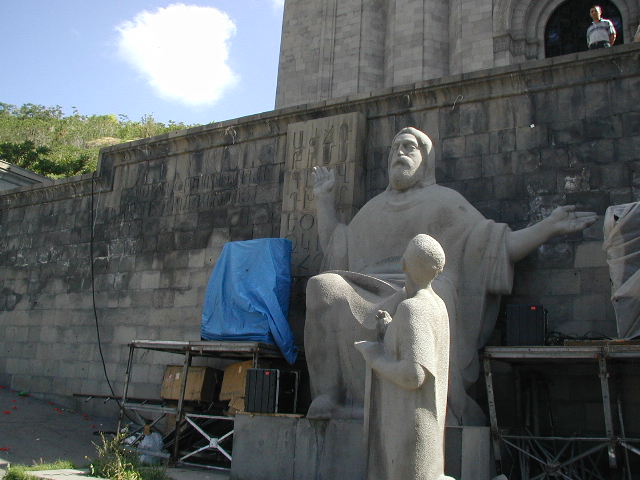
The manuscript exhibit upstairs is toured in the Russian fashion, i.e. a woman with a stick points to things and talks. The oldest manuscript is a copy of the Gospel of Lazarus from the 9th century C.E.. Most of the mansucripts on display are medieval copies of earlier manuscripts. The claim is that the Armenian translations are the only surviving copies of various Greek and Persion classical works. Whether or not that's true, many of the manuscripts are beautifully illuminated. One thing that I found particularly interesting was the red cantillation markings on several music manuscripts. Nobody knows how to read these now, however.
There were also a lot of "miniatures" (i.e. drawings or paintings that were part of the illumination) and the guide explained the colors. Cochineal was used for red, lapis lazuli for blue, and a copper compound for green. Gold leaf was stuck on with garlic juice. Another interesting exhibit was of the largest and smallest works in the collection. The largest is a 15th century history which consisted of pages that were each made of an entire calf skin. It was torn in half by two women and carried to safety from a 19th century massacre. There are also some interesting bindings, including a very unusual one of carved ivory. The only disappointing exhibit is the one of manuscripts in languages other than Armenian, none of which were particularly notable. All in all, the Matenadaran was the definite highlight of Armenia for me.
We continued on to Vernissage, a weekend market. The items for sale include souvenirs and art, but also household items, hardware, and general goods. A lot of the stuff is pretty insipid tourist tat (e.g. obsidian pen and pencil sets saying "I Love Armenia") and a lot is not particularly Armenian (e.g. rows and rows of matrushkas). But I was able to find a pair of dolls for my collection and a CD of Armenian dance music. By the way, this is also a very good place for people watching.
The rest of the day's touring involved an excursion to Echmiadzin. The first site there is the Church of Saint Hripsime, which dates from the 7th century. The story is that Hripsime was one of 40 Christian virgins who were proselytizing in the region. When she refused to marry King Trdates III, he had them all killed. The church is of very solid stone, with a tall unsupported dome. Underneath, there's a crypt where St. Hripsime's bones are said to be buried.
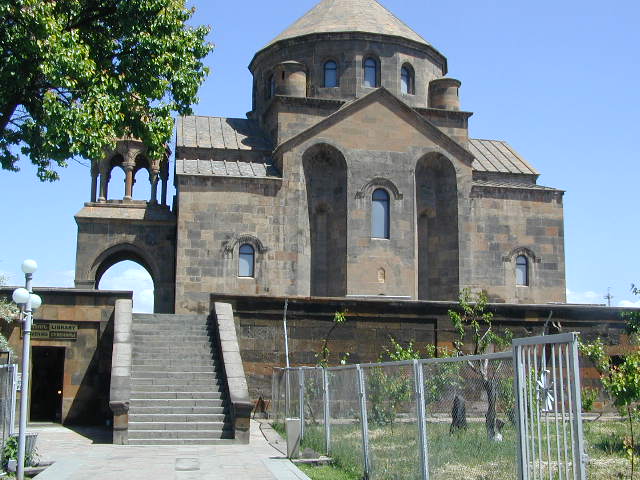
A more impressive site is the Cathedral of Echmiadzin, which is the mother church of Armenian Christianity, often referred to as the Armenian equivalent of the Vatican. The large complex includes a large outdoor altar, the home of the Catholicos (Patriarch), and a theological seminary, as well as the church. There are a lot of seminarians. The ones in the early years of their studies wear grey robes and they later "graduate" to black robes. It takes six years to become a priest, after which they can stay on in a monastic order if they want to.
There's a long row of khachkars at the site, too. These stone crosses originated as a Christianization of the pagan "dragon stones" (your basic phallic fertility worship object) and are an art form that is unique to Armenia. According to Anna, no two are identical. Not having seen every single one ever carved, I can't comment on that. They are, however, quite nicely carved.
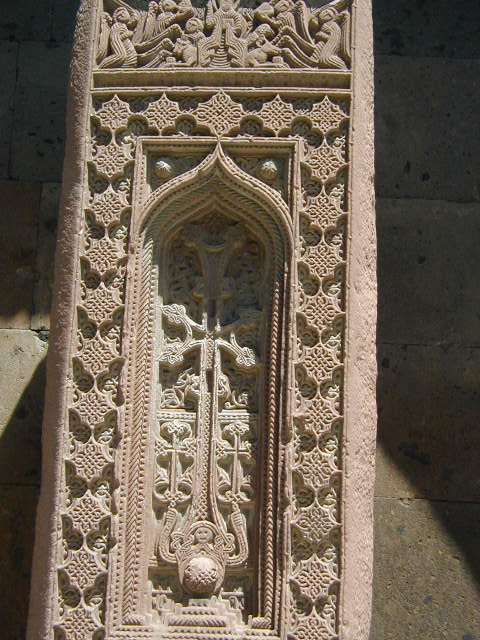
Eventually, we went into the cathedral itself. If nothing else, I was glad to get out of the sun. There are magnificent frescoes at the entrance and the walls are richly decorated. There's also an ornate gold throne for the Catholicos. It's fairly grand, though it's not really anywhere near the size or splendor of the Vatican. Incidentally, you might notice that the altar is open to view. This was true in all of the Armenian churches I visited and is unlike other Orthodox churches, where the altar is hidden by an icon screen (called an iconostasis).
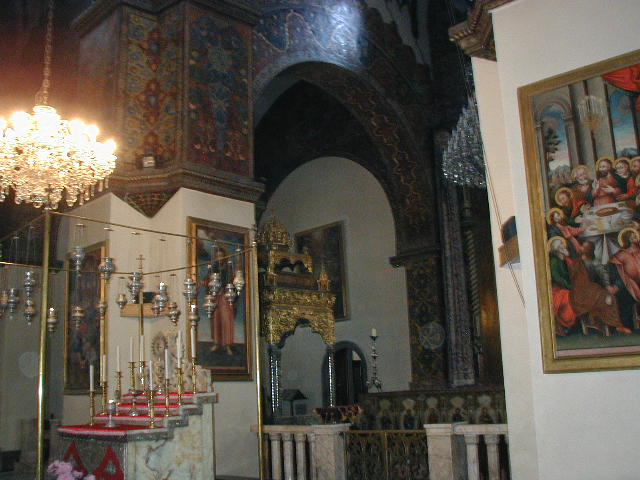
The Treasury is said to be quite interesting, containing such things as a piece of Noah's ark and a spearhead that supposedly pierced the side of Jesus, as well as the usual jeweled chalices and vestments and such. There's also supposed to be the remains of a Zorastrian fire temple under the cathedral. However, true to pattern, all of this was closed for reconstruction. So we moved on to lunch at a brewpub and returned to Yerevan.
My final day of touring began with a visit to the Khor Virap Monastery, about 30 kilometers south of Yerevan. There were good views of Mount Ararat along the way, and an excellent view from the monastery itself. You can't go to Ararat, of course, because it's closed for reconstruction. Actually, it's over the border in Turkey, but that's pretty much the same thing from the Armenian standpoint.
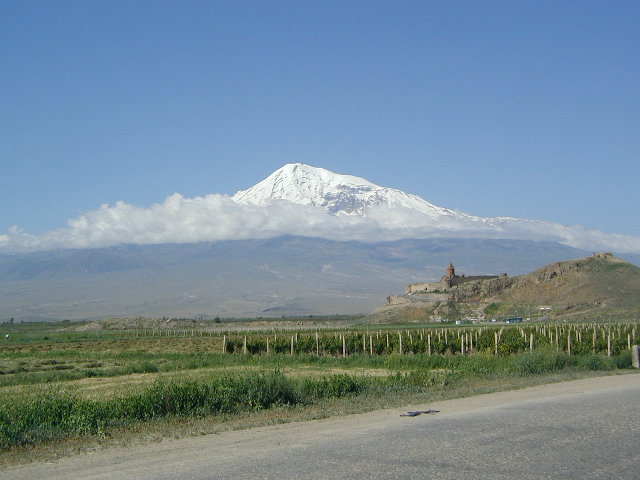
As for Khor Virap itself, the site was a royal prison around the 3rd or 4th century C.E. and is where King Trdates III had Gregory the Illuminator imprisoned. If you really want to, you can climb down a metal ladder into the dungeon / well which Gregory lived in for twelve years. Apparently a lot of people really want to, because there was quite a long line for this. The story is that Gregory survived because a woman had a dream in which an angel told her to bring him food and water. Gregory asked if "that swine" (meaning Trdates III) was still alive - and Trdates turned into a pig. (Or, depending on what version you believe, he just went mad and thought he was a pig. Most people find the "went mad" part reasonably plausible.) Anyway, Trdates had a sister and she dreamt that Gregory could cure the king, so he was freed. The king was so grateful for the cure, that he converted to Christianity and made it the state religion. The actual monastery is not contemporary with the story, however, and dates from the 12th century.
We drove back through Yerevan and on to Garni, which is roughly 26 kilometers east of the city. Part of the road there was very bad, mostly due to erosion. The reason to go there is to see a reconstructed pagan temple, built in the 1st century C.E. by King Trdates I. The building collapsed in an earthquake in 1679 and was reconstructed in the late 1960's. You can see the new stone used in the rebuilding, which contrasts with the original. Nobody is positive, but it is believed to have been a temple to the sun god, Mithra (according to Anna) or Helios (according to Lonely Planet).
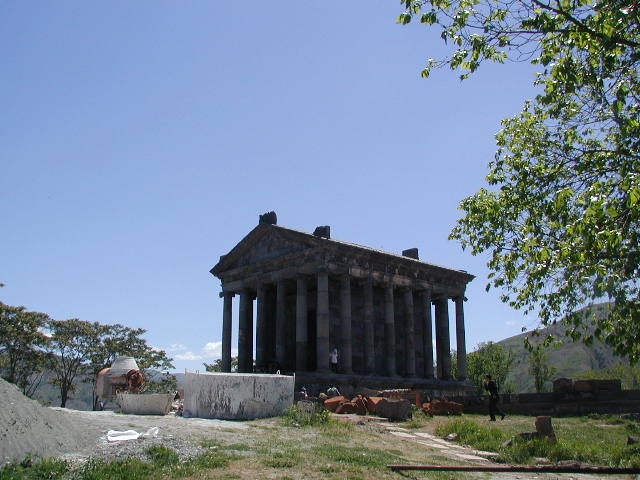
We climbed up the steps and looked in, then descended and walked over to the ruins of a bathhouse. That has a famous mosaic that reads (in Greek), "we worked, but did not get anything." This is believed to be a reference to slaves having built the work. By the way, the bathhouse ruins are behind glass in a modern structure. Anna said that when the current reconstruction is done, there will be a glass bridge over the structure.
The final sightseeing stop was Geghard Monastery, which was quite near to Garni. This is basically a 13th century complex and, while part of it is a building, the more interesting part was carved into the rock. According to Anna, it was the work of a single man and took him 50 years.
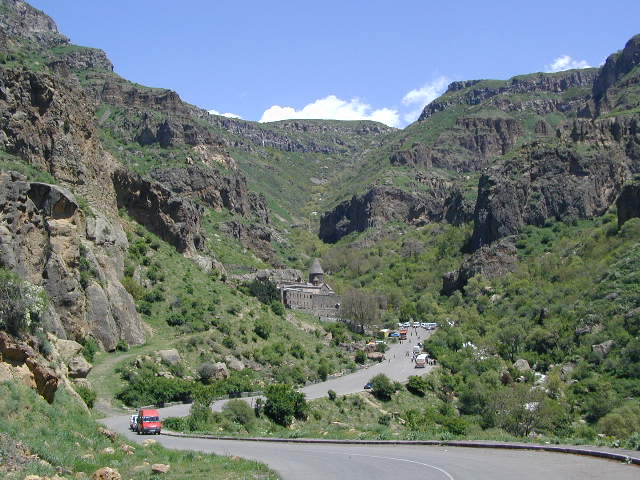
One of the chapels has a natural spring which people drink from or wash in in order to have wishes granted. There's a lot of elaborate carving, including several khachkars. On the second floor, a burial chamber was also carved out of the rock, with an opening looking down on the church below. In addition, there are a lot of monastic cells. All in all, it's pretty impressive.
My farewell dinner was at a restaurant called Old Erivan, sort of near the Opera House. The restaurant has several levels, each decorated in the style of a different period of Armenian history and we ate on the medieval level. The food was a mixture of Armenian and more generic Middle Eastern food and was all quite tasty. There was excellent tabbouli, hummus, and something I'd consider baba ghanoush but that Anna called by another name. That was followed by blini filled with chicken and mushrooms. Finally, there was kufta (basically meatloaf) of two types. One is the Eastern Armenian style, which I found a bit bland. The Western Armenian style has bulgur mixed in and fried into a sort of shell and was far nicer. Of course, there was coffee, and I sampled the famous Armenian cognac, which is very smooth. I also enjoyed the live entertainment and was convinced that I'd heard one of the songs before, though I have no idea where.
The airport in Yerevan is small and chaotic. While I waited in line with my bag, Anna bought the departure tax certificate (10,000 dram, which is roughly USD 20). When I checked in, they gave me a boarding pass only as far as Heathrow - presumably because there don't seem to be any computers at the airport. The baggage tag was also handwritten, though at least they could check my bag through to Washington Dulles. The real challenge came at passport control. The photo page of my passport has started delaminating and they decided that this made it questionable. They kept me waiting several minutes, discussing this amongst one another. Finally, they allowed me to show additional identification and let me through. At least nobody asked me to fill out a customs declaration or to show the one that I hadn't been able to get a copy of when entering the country. Eventually it was time to board and I was on my way back to Heathrow.
Which means it's time for my random observations about Armenia:
Back to Previous Chapter | Back to Caucasus Index | On to Next Chapter | Xenophilia Home
Copyright 2003 Miriam H. Nadel
last updated 11 June 2003